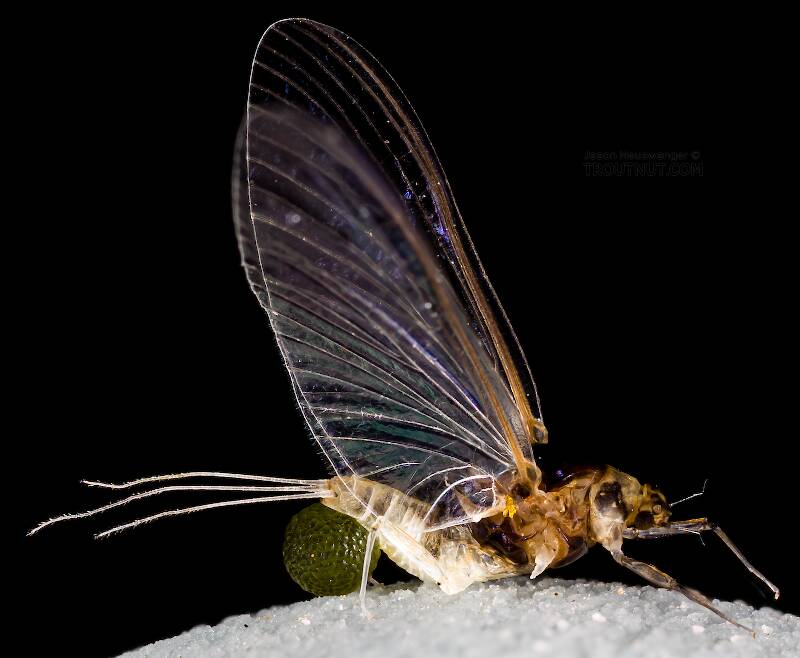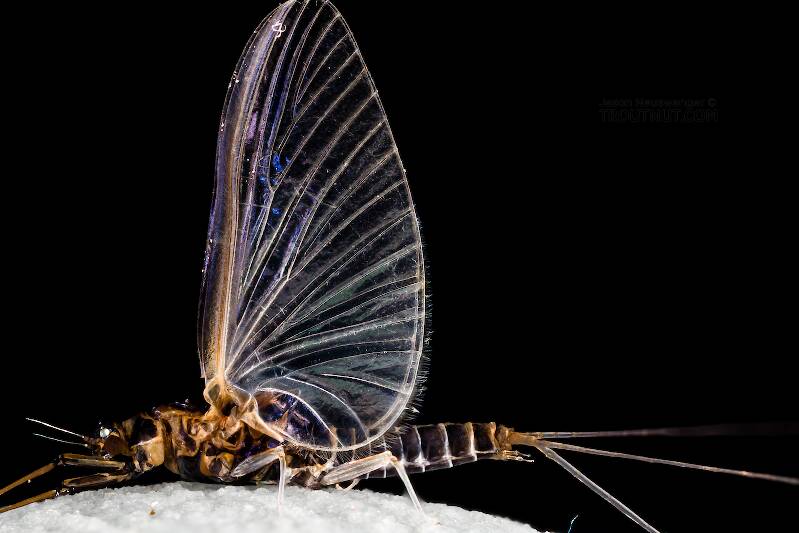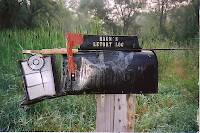
Hex Mayflies
Hexagenia limbata
The famous nocturnal Hex hatch of the Midwest (and a few other lucky locations) stirs to the surface mythically large brown trout that only touch streamers for the rest of the year.
Featured on the forum

This species was fairly abundant in a February sample of the upper Yakima.

Troutnut is a project started in 2003 by salmonid ecologist Jason "Troutnut" Neuswanger to help anglers and
fly tyers unabashedly embrace the entomological side of the sport. Learn more about Troutnut or
support the project for an enhanced experience here.
This topic is about the Mayfly Genus Tricorythodes
A cult following is something to which few insects can lay claim, but the tiny Tricorythodes mayflies certainly qualify. Their widespread, reliable, heavy hatches draw impressive rises of ultra-selective trout which demand the most of a technical dry-fly angler's skills.It is surprising that such a great hatch took so long to come to the attention of fly fishermen. The Tricos were first introduced to anglers in a 1969 Outdoor Life article by Vincent Marinaro, who misidentified them as Caenis. By the early 1970s the identification had been corrected but Swisher and Richards still wrote in Selective Trout, "Few anglers are familiar with these extremely small but important mayflies." The next wave of publications boosted Tricorythodes to its current fame. I suspect their early dismissal was due in part to tackle limitations; anglers in the 1950s had no means to effectively tie and present size 22-28 flies.
Example specimens
Grabbit on Aug 9, 2007August 9th, 2007, 4:30 pm EDT
I thought I would put these trico patterns up on this board as it gets the most attention and they might have a better chance of finding their way to the person that was looking for new ideas. These patterns are material specific and all proven on the water. I am a small fly fanatic, I use a double zero wt. sage with very light/long tippet. I do hunt for big fish.... yes it is true.
Two summers ago I used nothing but dun patterns, all thorax patterns and few Catskills mixed in for good measure. The results where incredible with the fully hackled thorax dun patterns. Who says that spinner patterns are the only way to fly during the trico season... wrong! wrong! wrong!
After the spinners are drowned and well down river the sporadic tricos that sparkle like diamonds over the slick holds get plenty of attention. I again tested these pattern on Spring Creek last year with like results... testing grounds were WELL below the pardise on a well known road curve in that river (yea that multi micro current ego bashing pool) I had several misses and finally some scores that lifted my spirits before the rain spoiled the rest of the trip. If you know the pool I speak of you may also know never let a big fish get below you as the battle will soon be over and the walk back up to the bridge will be L-------------------------------o-----------n-----------------g. If you like the fly's and need a materials list let me know. OUT.

THORAX TRICO QUILL BODY

TRAILING SHUCK PARATRICO

CDC EMERGING TRICO
.
HOW MANY TIMES DO WE HAVE TO GO THRU THIS???? PLEASE STAY OUT OF MY FRIGGIN BACKCAST.....Grabbit.....
Two summers ago I used nothing but dun patterns, all thorax patterns and few Catskills mixed in for good measure. The results where incredible with the fully hackled thorax dun patterns. Who says that spinner patterns are the only way to fly during the trico season... wrong! wrong! wrong!
After the spinners are drowned and well down river the sporadic tricos that sparkle like diamonds over the slick holds get plenty of attention. I again tested these pattern on Spring Creek last year with like results... testing grounds were WELL below the pardise on a well known road curve in that river (yea that multi micro current ego bashing pool) I had several misses and finally some scores that lifted my spirits before the rain spoiled the rest of the trip. If you know the pool I speak of you may also know never let a big fish get below you as the battle will soon be over and the walk back up to the bridge will be L-------------------------------o-----------n-----------------g. If you like the fly's and need a materials list let me know. OUT.

THORAX TRICO QUILL BODY

TRAILING SHUCK PARATRICO

CDC EMERGING TRICO
.
HOW MANY TIMES DO WE HAVE TO GO THRU THIS???? PLEASE STAY OUT OF MY FRIGGIN BACKCAST.....Grabbit.....
Fishing with nymphs is for fat little kids... man up and throw a dry.
Troutnut on Aug 9, 2007August 9th, 2007, 4:40 pm EDT
Great flies, Grabbit! The proportions are spot-on as far as apparent body shape goes, an unusual achievement with Tricos. I don't doubt those work great. Thanks for posting them.
I'm moving the post to the Trico section, actually. All posts in all sections get lots of initial attention by being featured on the forum front page (I don't like having stuff buried in low-traffic forum sections, either). Most people browse from there. Because I moved it to the Trico section, anyone who comes to the site looking for Trico information will find your post easily, too.
I thought I would put these trico patterns up on this board as it gets the most attention aas they might have a better chance of finding their way to the person that was looking for them.
I'm moving the post to the Trico section, actually. All posts in all sections get lots of initial attention by being featured on the forum front page (I don't like having stuff buried in low-traffic forum sections, either). Most people browse from there. Because I moved it to the Trico section, anyone who comes to the site looking for Trico information will find your post easily, too.
Jason Neuswanger, Ph.D.
Troutnut and salmonid ecologist
Troutnut and salmonid ecologist
Martinlf on Aug 9, 2007August 9th, 2007, 6:03 pm EDT
Way cool. I'm a Trico nut myself. I'll pull up my old Trico posts so you can take a look.
"He spread them a yard and a half. 'And every one that got away is this big.'"
--Fred Chappell
--Fred Chappell
Shawnny3 on Aug 10, 2007August 10th, 2007, 4:18 am EDT
Very nice flies, Grabbit. And I don't say that much. At least not in earnest.
-Shawn
-Shawn
Jewelry-Quality Artistic Salmon Flies, by Shawn Davis
www.davisflydesigns.com
www.davisflydesigns.com
Turboboy
Posts: 5
Posts: 5
Turboboy on Aug 24, 2007August 24th, 2007, 4:39 am EDT
i do like the look of those . one of my main issues with trico patterns is being visible to me on the water. depending on the lighting on the stream i find many patterns that are low viz to the angler produce takes that go unnoticed. your patterns look to be as visible as one would expect for a size 22-24 hook. i might tie up some similar perhaps with a yellow or chartreuse wing or post. going out tomorrow am for the trico hatch !! thanks for sharing john
Jack_k on Oct 24, 2008October 24th, 2008, 7:21 pm EDT
Here in Nevada, nearly every reservoir from So. central to the No. part of the state has a heavy hatch of Little White Winged Blacks (Tricos). I haven't noticed them as much in the streams, but starting in mid may they are like smoke over the reservoirs (till the wind blowes). This hatch lasts for several weeks and the feeding frenzy that accompanies this hatch is a site to behold. It's as if Alfred Hitchcock were alive and making a movie called "The Fish". There will be 10 to 20 riseforms within 20 yards. I have macro videos of these tricos landing on my blue truck, wiggling out of the primary shuck, and flying off. They go "delta winged" as they wiggle from the shuck, it's very cool to see.
I use a standard spent wing pattern, #18 hook,black 6.0 thread for a body and Calf tail for spent wing effect. Wings should be no wider than 5/8". Remember, 3 tails. Jack_K Just2ty4.com
I use a standard spent wing pattern, #18 hook,black 6.0 thread for a body and Calf tail for spent wing effect. Wings should be no wider than 5/8". Remember, 3 tails. Jack_K Just2ty4.com
Taxon on Oct 25, 2008October 25th, 2008, 9:45 am EDT
Jack-
What time of day does this emergence take place? Is it in the morning, or in the late afternoon and earlier on dark days? The reason I ask is that I went to you website, and believe the photo you identified as a White Winged Black (Tricorythodes) is actually a White-Winged Sulphur (Caenis).
What time of day does this emergence take place? Is it in the morning, or in the late afternoon and earlier on dark days? The reason I ask is that I went to you website, and believe the photo you identified as a White Winged Black (Tricorythodes) is actually a White-Winged Sulphur (Caenis).
Quick Reply
Related Discussions
Topic
Replies
Last Reply
1
Oct 24, 2006
by Troutnut
by Troutnut
5
Aug 6, 2009
by DocWet
by DocWet
6
Sep 11, 2020
by Martinlf
by Martinlf
2
Jul 9, 2018
by Martinlf
by Martinlf









